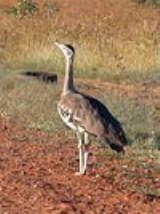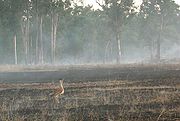
Australian Bustard
Encyclopedia
The Australian Bustard, Ardeotis australis, is a large ground bird of grassland, woodland and open agricultural country across northern Australia
and southern New Guinea
. It is also commonly referred to in Central Australia
as the Bush Turkey, particularly by Aboriginal
people.
The male is up to 1.2 m (47.2 in) tall with a 2.3 m (7.5 ft) wingspan. The average weight for males is 6.3 kg (13.9 lb), with a range of 4.3 to 12.76 kg (9.5 to 28.1 lb). The female is quite a bit smaller at 80 cm (31.5 in) tall and 3.2 kg (7.1 lb), with a range of 2.4 to 6.35 kg (5.3 to 14 lb) but is similarly coloured. The largest male was shot just outside Victoria
and was 14.5 kg (32 lb). Although it is the largest extant flying land bird in Australia, this long-legged bird is the smallest species in the Ardeotis genus. The back, wings and tail are dull brown, mottled black and white markings on the wing coverts. The neck and head appear dull white and the crown black. Legs are yellow to cream coloured.
When disturbed, Australian Bustards often adopt a cryptic pose with neck erect and bill pointed skywards. They may stalk gradually away or run if alarmed, taking flight as a last resort. Populations are highly nomadic following rain and feed, which includes seeds, fruit, centipedes, insects, molluscs, lizards, young birds and small rodents.
 This bird remains relatively common and widespread across most of northern Australia (see Atlas), but its range appears to have contracted in the south-east of the continent
This bird remains relatively common and widespread across most of northern Australia (see Atlas), but its range appears to have contracted in the south-east of the continent
during the last century, perhaps due to hunting (now illegal except for indigenous Australians), feral predators such as pigs and foxes and habitat destruction. Its nomadic habits make it difficult to assess.
The Australian Bustard is not listed as threatened on the Environment Protection and Biodiversity Conservation Act 1999
.
generally refer to this bird as the Bush Turkey. It is an important food source for Aboriginal people from Central Australia
, and is still eaten today. The white feathers of the bird are used for ceremonial purposes.
The Arrernte
name for this bird is kere artewe. The Luritja
name is kipara . The Larrakia
name for this bird is danimila.
There are important Dreaming
stories associated with the Bush Turkey. A number of artists painting in the desert today paint bush turkey Dreaming. This means they have been given stories of the origins of the turkey in the Dreamtime
and are entitled to tell this story and paint about it.
Australia
Australia , officially the Commonwealth of Australia, is a country in the Southern Hemisphere comprising the mainland of the Australian continent, the island of Tasmania, and numerous smaller islands in the Indian and Pacific Oceans. It is the world's sixth-largest country by total area...
and southern New Guinea
New Guinea
New Guinea is the world's second largest island, after Greenland, covering a land area of 786,000 km2. Located in the southwest Pacific Ocean, it lies geographically to the east of the Malay Archipelago, with which it is sometimes included as part of a greater Indo-Australian Archipelago...
. It is also commonly referred to in Central Australia
Central Australia
Central Australia/Alice Springs Region is one of the five regions in the Northern Territory. The term Central Australia is used to describe an area centred on Alice Springs in Australia. It is sometimes referred to as Centralia; likewise the people of the area are sometimes called Centralians...
as the Bush Turkey, particularly by Aboriginal
Indigenous Australians
Indigenous Australians are the original inhabitants of the Australian continent and nearby islands. The Aboriginal Indigenous Australians migrated from the Indian continent around 75,000 to 100,000 years ago....
people.
The male is up to 1.2 m (47.2 in) tall with a 2.3 m (7.5 ft) wingspan. The average weight for males is 6.3 kg (13.9 lb), with a range of 4.3 to 12.76 kg (9.5 to 28.1 lb). The female is quite a bit smaller at 80 cm (31.5 in) tall and 3.2 kg (7.1 lb), with a range of 2.4 to 6.35 kg (5.3 to 14 lb) but is similarly coloured. The largest male was shot just outside Victoria
Victoria (Australia)
Victoria is the second most populous state in Australia. Geographically the smallest mainland state, Victoria is bordered by New South Wales, South Australia, and Tasmania on Boundary Islet to the north, west and south respectively....
and was 14.5 kg (32 lb). Although it is the largest extant flying land bird in Australia, this long-legged bird is the smallest species in the Ardeotis genus. The back, wings and tail are dull brown, mottled black and white markings on the wing coverts. The neck and head appear dull white and the crown black. Legs are yellow to cream coloured.
When disturbed, Australian Bustards often adopt a cryptic pose with neck erect and bill pointed skywards. They may stalk gradually away or run if alarmed, taking flight as a last resort. Populations are highly nomadic following rain and feed, which includes seeds, fruit, centipedes, insects, molluscs, lizards, young birds and small rodents.
Conservation status

Australia (continent)
Australia is the world's smallest continent, comprising the mainland of Australia and proximate islands including Tasmania, New Guinea, the Aru Islands and Raja Ampat Islands...
during the last century, perhaps due to hunting (now illegal except for indigenous Australians), feral predators such as pigs and foxes and habitat destruction. Its nomadic habits make it difficult to assess.
The Australian Bustard is not listed as threatened on the Environment Protection and Biodiversity Conservation Act 1999
Environment Protection and Biodiversity Conservation Act 1999
The Environment Protection and Biodiversity Conservation Act 1999 is an Act of the Parliament of Australia that provides a framework for protection of the Australian environment, including its biodiversity and its natural and culturally significant places...
.
Victoria
- The Australian Bustard is listed as threatened on the Victorian Flora and Fauna Guarantee Act 1988. Under this Act, an Action Statement for the recovery and future management of this species has been prepared.
- On the 2007 advisory list of threatened vertebrate fauna in Victoria, this species is listed as critically endangeredCritically endangeredVersion 2010.3 of the IUCN Red List of Threatened Species identified 3744 Critically Endangered species, subspecies and varieties, stocks and subpopulations.Critically Endangered by kingdom:*1993 Animalia*2 Fungi*1745 Plantae*4 Protista-References:...
.
Aborigines and Bush turkeys
Australian AboriginesAustralian Aborigines
Australian Aborigines , also called Aboriginal Australians, from the latin ab originem , are people who are indigenous to most of the Australian continentthat is, to mainland Australia and the island of Tasmania...
generally refer to this bird as the Bush Turkey. It is an important food source for Aboriginal people from Central Australia
Central Australia
Central Australia/Alice Springs Region is one of the five regions in the Northern Territory. The term Central Australia is used to describe an area centred on Alice Springs in Australia. It is sometimes referred to as Centralia; likewise the people of the area are sometimes called Centralians...
, and is still eaten today. The white feathers of the bird are used for ceremonial purposes.
The Arrernte
Arrernte people
The Arrernte people , known in English as the Aranda or Arunta, are those Indigenous Australians who are the original custodians of Arrernte lands in the central area of Australia around Mparntwe or Alice Springs in the Northern Territory. The Arrernte tribe has lived there for more than 20,000 years...
name for this bird is kere artewe. The Luritja
Luritja
Luritja is a name used to refer to several dialects of the Indigenous Australian Western Desert Language, and thereby also to the people who speak these varieties, and their traditional lands.-Origin and meaning of Luritja:...
name is kipara . The Larrakia
Larrakia
Larrakia are the Aboriginal Traditional Owners of Larrakia Country which includes the area in and around Darwin, Northern Territory in Australia...
name for this bird is danimila.
There are important Dreaming
Dreaming (spirituality)
The Dreaming is a common term within the animist creation narrative of indigenous Australians for a personal, or group, creation and for what may be understood as the "timeless time" of formative creation and perpetual creating....
stories associated with the Bush Turkey. A number of artists painting in the desert today paint bush turkey Dreaming. This means they have been given stories of the origins of the turkey in the Dreamtime
Dreamtime
In the animist framework of Australian Aboriginal mythology, The Dreaming is a sacred era in which ancestral Totemic Spirit Beings formed The Creation.-The Dreaming of the Aboriginal times:...
and are entitled to tell this story and paint about it.
External links
- NSW National Parks and Wildlife Service Threatened Species Information sheet (PDF accessed 27 July 2006)

